Early Ediacaran Magmatism in the Yenisei Ridge and Evolution of the Southwestern Margin of the Siberian Craton
Abstract
:1. Introduction
2. Geological Setting
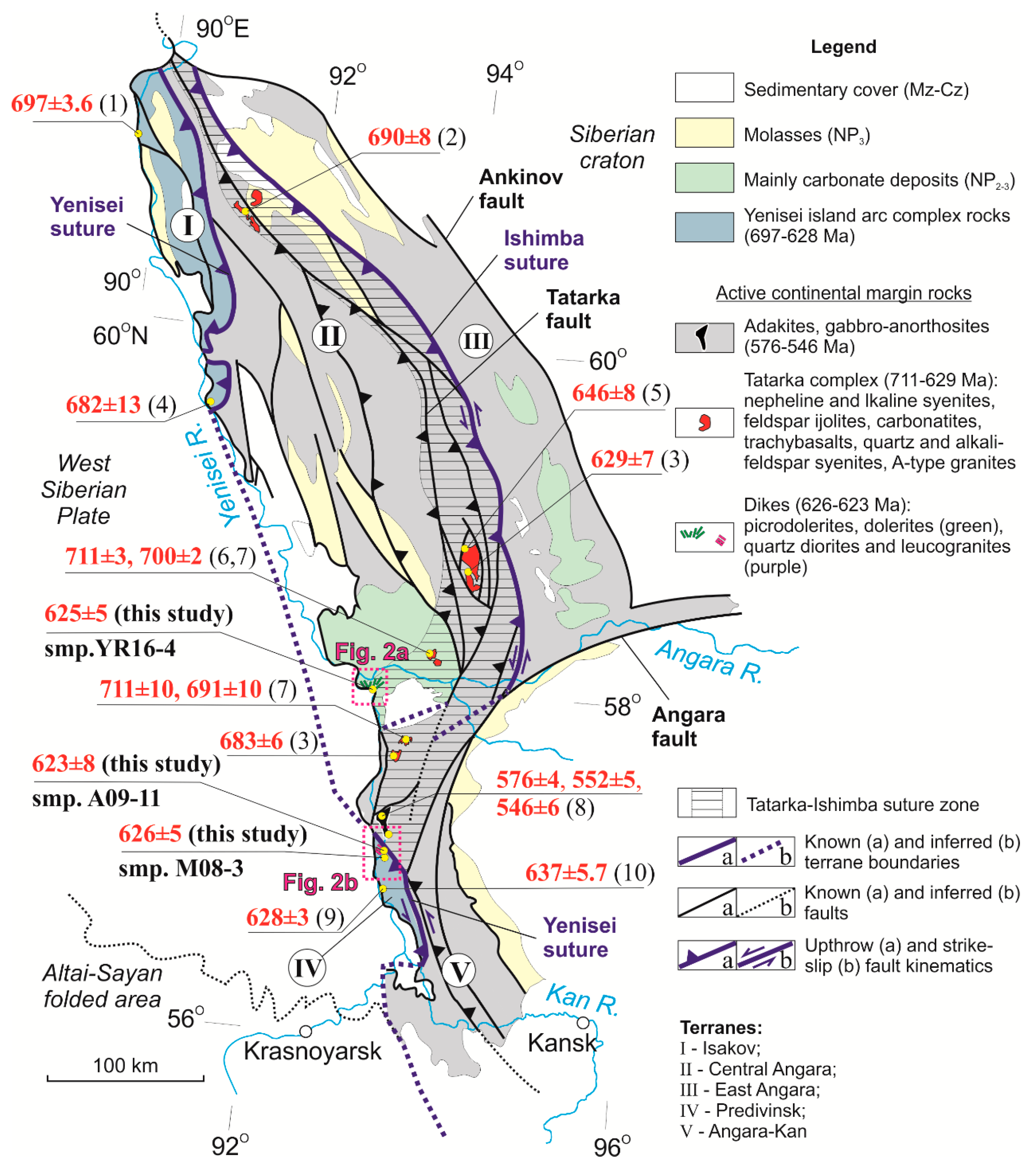


3. Analytical Methods
| Sample/Component | 04ek07 | A09-15-1 | A09-16-1 | YR-16-4 | A09-17 | A09-16-2 | 04ek10 | A09-15 | 04ek06 | 04ek02 | A09-11 | M08-3 | M08-2 | Detection Limits | |||
|---|---|---|---|---|---|---|---|---|---|---|---|---|---|---|---|---|---|
| 1 | 2 | 3 | 4 | 5 | 6 | 7 | 8 | 9 | 10 | 11 | 12 | 13 | 7, 9 | 2–6, 8 | 11–13 | 1, 10 | |
| Picrodolerites | Dolerites | Qu-Diorite | Leucocratic Granites | ||||||||||||||
| SiO2, wt.% | 42.87 | 43.75 | 44.82 | 44.90 | 44.86 | 44.98 | 45.19 | 47.87 | 48.65 | 49.09 | 58.68 | 74.10 | 74.89 | 0.1 | 0.1 | 0.1 | 0.1 |
| TiO2 | 1.53 | 1.39 | 1.14 | 1.16 | 1.45 | 1.08 | 1.25 | 1.32 | 1.26 | 1.30 | 0.80 | 0.09 | 0.02 | 0.005 | 0.005 | 0.005 | 0.005 |
| Al2O3 | 13.58 | 13.50 | 13.69 | 14.13 | 13.75 | 13.49 | 14.99 | 15.52 | 16.04 | 15.56 | 16.36 | 14.90 | 14.93 | 0.1 | 0.1 | 0.1 | 0.1 |
| Fe2O3* | 9.63 | 10.78 | 11.80 | 11.72 | 11.26 | 11.97 | 9.97 | 10.95 | 8.86 | 8.93 | 7.51 | 1.10 | 0.66 | 0.005 | 0.005 | 0.005 | 0.005 |
| MnO | 0.16 | 0.11 | 0.16 | 0.16 | 0.12 | 0.15 | 0.17 | 0.17 | 0.14 | 0.15 | 0.11 | 0.04 | 0.02 | 0.005 | 0.005 | 0.005 | 0.005 |
| MgO | 10.35 | 10.60 | 11.61 | 11.05 | 11.44 | 12.74 | 11.79 | 6.34 | 7.58 | 7.52 | 2.51 | 0.34 | 0.16 | 0.05 | 0.05 | 0.05 | 0.05 |
| CaO | 8.84 | 6.84 | 7.57 | 7.92 | 6.84 | 7.06 | 6.28 | 8.46 | 7.37 | 7.38 | 5.48 | 1.54 | 1.54 | 0.01 | 0.01 | 0.01 | 0.01 |
| Na2O | 1.75 | 1.47 | 1.54 | 1.41 | 1.76 | 1.29 | 1.72 | 2.82 | 2.28 | 2.40 | 5.98 | 3.19 | 4.49 | 0.1 | 0.1 | 0.1 | 0.1 |
| K2O | 0.69 | 0.45 | 0.66 | 0.70 | 0.85 | 0.57 | 0.98 | 0.55 | 0.48 | 0.59 | 0.48 | 3.81 | 2.85 | 0.01 | 0.01 | 0.01 | 0.01 |
| P2O5 | 0.25 | 0.20 | 0.17 | 0.17 | 0.21 | 0.17 | 0.19 | 0.18 | 0.18 | 0.19 | 0.17 | 0.05 | 0.03 | 0.01 | 0.01 | 0.01 | 0.01 |
| LOI | 9.13 | 11.20 | 6.65 | 6.46 | 7.43 | 6.38 | 6.17 | 6.12 | 5.97 | 5.57 | 2.12 | 0.79 | 0.29 | ||||
| Total | 98.78 | 100.29 | 99.81 | 99.78 | 99.97 | 99.88 | 98.70 | 100.30 | 98.81 | 98.68 | 100.20 | 99.95 | 99.88 | ||||
| Rb, ppm | 24.20 | 24.30 | 22.60 | 24.90 | 46.60 | 23.60 | 23.00 | 30.60 | 24.00 | 26.10 | 7.10 | 89.00 | 100 | 0.13 | 0.12 | 3.11 | 0.5 |
| Sr | 365 | 180 | 193 | 210 | 279 | 175 | 408 | 326 | 245 | 334 | 251 | 166 | 107 | 1.09 | 0.48 | 18 | 3.0 |
| Y | 20.80 | 13.80 | 14.80 | 16.00 | 16.00 | 14.80 | 13.80 | 18.80 | 18.00 | 21.50 | 33.00 | 3.50 | 5.9 | 0.022 | 0.022 | 0.12 | 0.1 |
| Zr | 123.00 | 65.50 | 76.00 | 83.30 | 98.60 | 76.10 | n.d. | 100.00 | 107.00 | 89.30 | n.d. | 60.00 | 45 | 0.32 | 0.49 | 5.2 | 0.22 |
| Nb | 22.10 | 17.40 | 12.40 | 13.20 | 23.00 | 12.00 | 9.20 | 21.30 | 21.00 | 23.90 | 5.90 | 7.20 | 4.28 | 0.055 | 0.046 | 0.10 | 0.09 |
| Ba | 637 | 185 | 2808 | 3451 | 261 | 1241 | 248 | 265 | 279 | 384 | 595 | 604 | 218 | 3.09 | 4.37 | 12.3 | 5.5 |
| La | 25.20 | 14.30 | 15.50 | 15.30 | 17.60 | 13.60 | 16.00 | 17.90 | 14.70 | 17.30 | 10.80 | 2.89 | 2.27 | 0.081 | 0.11 | 0.92 | 0.06 |
| Ce | 50.20 | 27.00 | 31.20 | 29.70 | 35.10 | 27.10 | 34.00 | 34.30 | 34.00 | 34.10 | 26.00 | 7.40 | 4.43 | 0.074 | 0.096 | 0.99 | 0.06 |
| Pr | 6.80 | 3.41 | 3.40 | 3.61 | 4.17 | 3.00 | 3.73 | 4.11 | 3.72 | 4.80 | 3.73 | 1.04 | 0.6 | 0.012 | 0.011 | 0.036 | 0.03 |
| Nd | 26.50 | 15.10 | 13.90 | 14.90 | 16.80 | 13.30 | 17.00 | 16.20 | 17.00 | 18.40 | 18.00 | 4.54 | 2.56 | 0.039 | 0.37 | 0.14 | 0.03 |
| Sm | 5.36 | 3.32 | 2.98 | 3.13 | 3.48 | 2.89 | 3.33 | 3.62 | 3.64 | 4.18 | 4.89 | 1.35 | 0.9 | 0.0081 | 0.011 | 0.036 | 0.01 |
| Eu | 1.60 | 1.15 | 0.95 | 0.93 | 1.19 | 0.91 | 1.18 | 0.94 | 1.23 | 1.32 | 1.80 | 0.28 | 0.3 | 0.0027 | 0.0046 | 0.027 | 0.003 |
| Gd | 5.76 | 3.97 | 3.69 | 3.91 | 4.25 | 3.52 | 3.58 | 4.19 | 3.96 | 4.64 | 6.20 | 1.40 | 1.08 | 0.0095 | 0.021 | 0.037 | 0.02 |
| Tb | 0.80 | 0.54 | 0.53 | 0.56 | 0.59 | 0.49 | 0.46 | 0.62 | 0.58 | 0.77 | 1.06 | 0.21 | 0.17 | 0.0081 | 0.047 | 0.018 | 0.01 |
| Dy | 4.48 | 2.93 | 3.23 | 3.19 | 3.48 | 2.85 | 3.08 | 3.57 | 3.92 | 4.33 | 7.10 | 1.14 | 1.06 | 0.0065 | 0.0099 | 0.035 | 0.01 |
| Ho | 0.88 | 0.57 | 0.61 | 0.64 | 0.67 | 0.59 | 0.51 | 0.73 | 0.69 | 0.85 | 1.55 | 0.19 | 0.2 | 0.0017 | 0.0016 | 0.015 | 0.003 |
| Er | 2.24 | 1.45 | 1.80 | 1.84 | 1.91 | 1.68 | 1.41 | 2.05 | 1.88 | 2.48 | 4.67 | 0.55 | 0.5 | 0.0055 | 0.0089 | 0.22 | 0.02 |
| Tm | 0.32 | 0.20 | 0.24 | 0.25 | 0.24 | 0.23 | 0.19 | 0.28 | 0.28 | 0.39 | 0.73 | 0.07 | 0.1 | 0.0007 | 0.0019 | 0.014 | 0.01 |
| Yb | 1.92 | 1.18 | 1.59 | 1.60 | 1.60 | 1.46 | 1.14 | 1.77 | 1.64 | 2.17 | 5.20 | 0.44 | 0.67 | 0.0030 | 0.0098 | 0.027 | 0.02 |
| Lu | 0.32 | 0.17 | 0.24 | 0.25 | 0.23 | 0.24 | 0.16 | 0.26 | 0.25 | 0.31 | 0.79 | 0.06 | 0.1 | 0.0006 | 0.0015 | 0.017 | 0.003 |
| Hf | 3.76 | 1.54 | 1.96 | 2.70 | 2.61 | 1.86 | n.d. | 2.69 | 2.33 | 2.86 | n.d. | 2.45 | 1.54 | 0.017 | 0.034 | n.d. | 0.09 |
| Ta | 1.36 | 1.01 | 0.66 | 0.75 | 1.29 | 0.64 | n.d. | 1.16 | 1.20 | 1.32 | 0.49 | 0.49 | 0.57 | 0.043 | 0.068 | 0.0057 | 0.15 |
| Th | 4.56 | 1.98 | 1.84 | 1.88 | 2.66 | 1.71 | 2.11 | 1.91 | 2.46 | 2.24 | 9.90 | 4.87 | 3.23 | 0.025 | 0.027 | 0.11 | 0.03 |
| U | 1.04 | 0.59 | 0.38 | 0.40 | 0.60 | 0.35 | 0.38 | 0.46 | 0.53 | 0.62 | 0.78 | 1.17 | 0.36 | 0.0068 | 0.0051 | 0.053 | 0.02 |
| Na2O + K2O | 2.44 | 1.92 | 2.20 | 2.11 | 2.61 | 1.86 | 2.70 | 3.37 | 2.76 | 2.99 | 6.46 | 7.00 | 7.34 | ||||
| Na2O/K2O | 2.54 | 3.27 | 2.33 | 2.01 | 2.07 | 2.26 | 1.76 | 5.13 | 4.75 | 4.07 | 12.46 | 0.84 | 1.58 | ||||
| Σ REE | 132.38 | 75.29 | 79.86 | 79.81 | 91.31 | 71.86 | 85.77 | 91.84 | 87.49 | 96.04 | 92.52 | 21.56 | 14.94 | ||||
| (La/Yb)CN | 8.92 | 8.23 | 6.62 | 4.95 | 7.47 | 6.33 | 9.53 | 6.87 | 6.09 | 5.42 | 1.41 | 4.46 | 2.30 | ||||
| (La/Sm)CN | 2.94 | 2.69 | 3.25 | 3.05 | 3.16 | 2.94 | 3.00 | 3.09 | 2.52 | 2.58 | 1.38 | 1.34 | 1.58 | ||||
| (Gd/Yb)CN | 2.43 | 2.72 | 1.88 | 1.51 | 2.15 | 1.95 | 2.54 | 1.92 | 1.95 | 1.73 | 0.96 | 2.57 | 1.30 | ||||
| Eu/Eu* | 0.88 | 0.97 | 0.87 | 0.81 | 0.94 | 0.87 | 1.04 | 0.74 | 0.99 | 0.91 | 1.00 | 0.62 | 0.93 | ||||
| (Tb/Y)PM | 1.67 | 1.73 | 1.56 | 1.52 | 1.60 | 1.44 | 1.45 | 1.43 | 1.40 | 1.56 | 1.40 | 2.61 | 1.25 | ||||
| Mg# | 51.80 | 49.58 | 49.59 | 48.53 | 50.40 | 51.56 | 54.18 | 36.67 | 46.12 | 45.71 | 25.05 | 23.61 | 19.51 | ||||
4. Results
4.1. Petrography and Mineralogy
4.2. Geochemistry
4.3. Zircon Geochronology
5. Discussion
6. Conclusions
Supplementary Materials
Author Contributions
Funding
Acknowledgments
Conflicts of Interest
References
- Khomentovsky, V.V.; Shenfil’, V.Y.; Yakshin, M.S.; Butakov, E.P. Key Sections of Precambrian and Lower Cambrian Deposits in the Siberian Platform; Nauka: Moscow, Russia, 1972; 356p. (In Russian) [Google Scholar]
- Berzin, N.A.; Dobretsov, N.L. Geodynamic evolution of Southern Siberia in Late Precambrian-Early Paleozoic time. In Reconstruction of the Paleoasian Ocean; Coleman, R.G., Ed.; VSP International Sciences Publishers: Utrecht, The Netherlands, 1993; pp. 45–62. [Google Scholar]
- Khain, V.E.; Gusev, G.S.; Khain, E.V.; Vernikovsky, V.A.; Volobuyev, M.I. Circum-Siberian Neoproterozoic ophiolite belt. Ofioliti 1997, 21, 195–200. [Google Scholar]
- Vernikovsky, V.A.; Vernikovskaya, A.E.; Kotov, A.B.; Sal’nikova, E.B.; Kovach, V.P. Neoproterozoic accretionary and collisional events on the western margin of the Siberian Craton: New geological and geochronological evidence from the Yenisey Ridge. Tectonophysics 2003, 375, 147–168. [Google Scholar] [CrossRef]
- Sovetov, J.K.; Kulikova, A.E.; Medvedev, M.N. Sedimentary basins in the southwestern Siberian craton: Late Neoproterozoic–Early Cambrian rifting and collisional events. Geol. Soc. Am. Spec. Pap. 2007, 423, 549–578. [Google Scholar] [CrossRef]
- Vernikovsky, V.A.; Metelkin, D.V.; Vernikovskaya, A.E.; Matushkin, N.Y.; Kazansky, A.Y.; Kadilnikov, P.I.; Romanova, I.V.; Wingate, M.T.D.; Larionov, A.N.; Rodionov, N.V. Neoproterozoic tectonic structure of the Yenisei Ridge and formation of the western margin of the Siberian Craton based on new geological, paleomagnetic, and geochronological data. Rus. Geol. Geophys. 2016, 57, 47–68. [Google Scholar] [CrossRef]
- Filippov, Y.F. The Fore-Yenisei sedimentary basin: Seismic-geological model and geodynamic history. Rus. Geol. Geophys. 2017, 58, 371–383. [Google Scholar] [CrossRef]
- Vernikovskaya, A.E.; Vernikovsky, V.A.; Sal’nikova, E.B.; Datsenko, V.M.; Kotov, A.B.; Kovach, V.P.; Travin, A.V.; Yakovleva, S.Z. Yeruda and Chirimba granitoids (Yenisei Ridge) as indicators of Neoproterozoic collisions. Geol. I Geofiz. 2002, 43, 259–272. [Google Scholar]
- Vernikovskaya, A.E.; Vernikovsky, V.A.; Sal’nikova, E.B.; Kotov, A.B.; Kovach, V.P.; Travin, A.V.; Wingate, M.T.D. A-type leucogranite magmatism in the evolution of continental crust on the western margin of the Siberian Craton. Rus. Geol. Geophys. 2007, 48, 3–16. [Google Scholar] [CrossRef]
- Vernikovsky, V.A.; Vernikovskaya, A.E.; Sal’nikova, E.B.; Berezhnaya, N.G.; Larionov, A.N.; Kotov, A.B.; Kovach, V.P.; Vernikovskaya, I.V.; Matushkin, N.Y.; Yasenev, A.M. Late Riphean alkaline magmatism in the western framework of the Siberian Craton: A result of continental rifting or accretionary events? Dokl. Earth Sci. 2008, 419, 226–230. [Google Scholar] [CrossRef]
- Vernikovsky, V.A.; Vernikovskaya, A.E.; Sal’nikova, E.B.; Kotov, A.B.; Chernykh, A.I.; Kovach, V.P.; Berezhnaya, N.G.; Yakovleva, S.Z. New U–Pb data on the formation of the Predivinsk paleoisland-arc complex (Yenisei Ridge). Geol. I Geofiz. 1999, 2, 255–259. [Google Scholar]
- Vernikovsky, V.A.; Vernikovskaya, A.E.; Chernykh, A.I.; Sal’nikova, E.B.; Kotov, A.B.; Kovach, V.P.; Yakovleva, S.Z.; Fedoseenko, A.M. Porozhnaya granitoids of the Enisei ophiolite belt: Indicators of Neoproterozoic events on the Enisei Ridge. Dokl. Earth Sci. 2001, 381A, 1043–1046. [Google Scholar]
- Kuzmichev, A.B.; Paderin, I.P.; Antonov, A.V. Late Riphean Borisikha ophiolite (Yenisei Ridge): U-Pb zircon age and tectonic setting. Rus. Geol. Geophys. 2008, 49, 883–893. [Google Scholar] [CrossRef]
- Vernikovskaya, A.E.; Vernikovsky, V.A.; Matushkin, N.Y.; Kadil’nikov, P.I.; Romanova, I.V.; Larionov, A.N. Late Neoproterozoic adakites of the Yenisei Ridge (Central Siberia): Petrogenesis, geodynamics, and U/Pb age. Rus. Geol. Geophys. 2017, 58, 1154–1170. [Google Scholar] [CrossRef]
- Gladkochub, D.P.; Wingate, M.T.D.; Pisarevsky, S.A.; Donskaya, T.V.; Mazukabzov, A.M.; Ponomarchuk, V.A.; Stanevich, A.M. Mafic intrusions in southwestern Siberia and implications for a Neoproterozoic connection with Laurentia. Prec. Res. 2006, 147, 260–278. [Google Scholar] [CrossRef]
- Nozhkin, A.D.; Turkina, O.M.; Bayanova, T.B.; Berezhnaya, N.G.; Larionov, A.N.; Postnikov, A.A.; Travin, A.V.; Ernst, R.E. Neoproterozoic rift and within-plate magmatism in the Yenisei Ridge: Implications for the breakup of Rodinia. Rus. Geol. Geophys. 2008, 49, 503–519. [Google Scholar] [CrossRef]
- Vernikovsky, V.A.; Vernikovskaya, A.E.; Pease, V.L.; Gee, D.G. Neoproterozoic Orogeny along the margins of Siberia. In The Neoproterozoic Timanide Orogen of Eastern Baltica; Gee, D.G., Pease, V., Eds.; Geological Society, London, Memoirs: London, UK, 2004; Volume 30, pp. 233–247. [Google Scholar] [CrossRef]
- Vernikovsky, V.A.; Vernikovskaya, A.E. Tectonics and evolution of granitoid magmatism in the Yenisei Ridge. Rus. Geol. Geophys. 2006, 47, 35–52. [Google Scholar]
- Metelkin, D.V.; Vernikovsky, V.A.; Kazansky, A.Y. Neoproterozoic evolution of Rodinia: Constraints from new paleomagnetic data on the western margin of the Siberian craton. Rus. Geol. Geophys. 2007, 48, 32–45. [Google Scholar] [CrossRef]
- Metelkin, D.V.; Vernikovsky, V.A.; Matushkin, N.Y. Arctida between Rodinia and Pangea. Prec. Res. 2015, 259, 114–129. [Google Scholar] [CrossRef]
- Vernikovskaya, A.E.; Datsenko, V.M.; Vernikovsky, V.A.; Matushkin, N.Y.; Laevsky, Y.M.; Romanova, I.V.; Travin, A.V.; Voronin, K.V.; Lepekhina, E.N. Magmatism evolution and carbonatite-granite association in the Neoproterozoic active continental margin of the Siberian Craton: Thermochronological reconstructions. Dokl. Earth Sci. 2013, 448, 161–167. [Google Scholar] [CrossRef]
- Kachevsky, L.K.; Kachevskaya, G.I.; Grabovskaya, Z.M. Geological Map of the Yenisei Ridge, Scale 1:500,000; Krasnoyarskgeolsyemka: Krasnoyarsk, Russia, 1998. (In Russian) [Google Scholar]
- Vernikovskaya, A.E.; Vernikovsky, V.A.; Sal’nikova, E.B.; Kotov, A.B.; Kovach, V.P.; Travin, A.V.; Palessky, S.V.; Yakovleva, S.Z.; Yasenev, A.M.; Fedoseenko, A.M. Neoproterozoic postcollisional granitoids of the Glushikha complex, Yenisei Ridge. Petrology 2003, 11, 53–67. [Google Scholar]
- Vernikovsky, V.A.; Kazansky, A.Y.; Matushkin, N.Y.; Metelkin, D.V.; Sovetov, J.K. The geodynamic evolution of the folded framing and the western margin of the Siberian Craton in the Neoproterozoic: Geological, structural, sedimentological, geochronological, and paleomagnetic data. Rus. Geol. Geophys. 2009, 50, 380–393. [Google Scholar] [CrossRef] [Green Version]
- Vernikovskaya, A.E.; Vernikovsky, V.A.; Sal’nikova, E.B.; Datsenko, V.M.; Kotov, A.B.; Kovach, V.P. A Neoproterozoic anorogenic event in the Yenisei Ridge: New geochemical and isotopic-geochronological data. Dokl. Earth Sci. 2005, 403, 833–837. [Google Scholar]
- Romanova, I.V.; Vernikovskaya, A.E.; Vernikovsky, V.A.; Matushkin, N.Y.; Larionov, A.N. Neoproterozoic alkaline magmatism and associated igneous rocks in the western framing of the Siberian Craton: Petrography, geochemistry, and geochronology. Rus. Geol. Geophys. 2012, 53, 1176–1196. [Google Scholar] [CrossRef]
- Amosova, A.A.; Panteeva, S.V.; Tatarinov, V.V.; Chubarov, V.M.; Finkelshtein, A.L. X-ray fluorescent determination of the main rock-forming elements from 50 and 110 mg samples. Anal. I Kontrol Anal. Control 2015, 19, 130–138. [Google Scholar] [CrossRef] [Green Version]
- Smirnova, E.V.; Flem, B.; Anchutina, E.A.; Mysovskaya, I.N.; Lozhkin, V.I.; Petrov, L.L. Determination of REE, Y, Nb, Zr, Hf, Ta, Th and U in geological reference materials LSHC-1 and Amf-1 by solution and laser ablation ICP-MS. Geostand. Geoanalytic. Res. 2010, 34, 49–65. [Google Scholar] [CrossRef]
- Evensen, N.M.; Hamilton, P.S.; O’Nions, R.K. Rare-earth abundances in chondritic meteorites. Geochim. Cosmochim. Acta 1978, 41, 1199–1212. [Google Scholar] [CrossRef]
- McDonough, W.F.; Sun, S.-S. The composition of the Earth. Chem. Geol. 1995, 120, 223–253. [Google Scholar] [CrossRef]
- Black, L.P.; Kamo, S.L.; Allen, C.M.; Aleinikoff, J.N.; Davis, D.W.; Korsch, R.J.; Foudoulis, C. TEMORA 1: A new zircon standard for Phanerozoic U-Pb geochronology. Chem. Geol. 2003, 200, 155–170. [Google Scholar] [CrossRef]
- Wiedenbeck, M.; Allé, P.; Corfu, F.; Griffin, W.L.; Meier, M.; Oberli, F.; von Quadt, A.; Roddick, J.C.; Spiegel, W. Three natural zircon standards for U-Th-Pb, Lu-Hf, trace element and REE analyses. Geostand. Newslet. 1995, 11, 1–23. [Google Scholar] [CrossRef]
- Larionov, A.N.; Andreichev, V.A.; Gee, D.G. The Vendian alkaline igneous suite of northern Timan: Ion microprobe U–Pb zircon ages of gabbros and syenite. In The Neoproterozoic Timanide Orogen of Eastern Baltica, 1st ed.; Gee, D.G., Pease, V.L., Eds.; Geology. Society, London, Memoirs: London, UK, 2004; Volume 30, pp. 69–74. [Google Scholar] [CrossRef]
- Ludwig, K.R. SQUID 1.12 A User’s Manual. A Geochronological Toolkit for Microsoft Excel, 1st ed.; Berkeley Geochronology Center Special Publication: Berkeley, CA, USA, 2005; 22p, Available online: http://bgc.org/isoplot_etc/squid/SQUID2_5Manual.pdf (accessed on 21 June 2020).
- Ludwig, K.R. User’s Manual for ISOPLOT/Ex 3.22. A Geochronological Toolkit for Microsoft Excel, 3rd ed.; Berkeley Geochronology Center Special Publication: Berkeley, CA, USA, 2005; 71p, Available online: http://www.bgc.org/isoplot_etc/isoplot/Isoplot3_75-4_15manual.pdf (accessed on 21 June 2020).
- Stacey, J.S.; Kramers, J.D. Approximation of terrestrial lead isotope evolution by a two-stage model. Earth Planet. Sci. Let. 1975, 21, 207–221. [Google Scholar] [CrossRef]
- Whitney, D.L.; Evans, B.P. Abbreviations for names of rock-forming minerals. Am. Mineral. 2010, 91, 185–187. [Google Scholar] [CrossRef]
- Deer, W.A.; Howie, R.A.; Zussman, J. An Introduction to the Rock-Forming Minerals, 2nd ed.; Longman Scientific & Technical: London, UK, 1992; 696p. [Google Scholar]
- Morimoto, N. Nomenclature of Pyroxenes. Mineral. Petrol. 1988, 39, 55–76. [Google Scholar] [CrossRef]
- Nwe, Y.Y. Electron-probe studies of the earlier pyroxenes and olivines from the Skaergaard Intrusion, East Greenland. Contrib. Mineral. Petrol. 1976, 55, 105–126. [Google Scholar] [CrossRef]
- Gutiérrez, F.; Gioncada, A.; González Ferran, O.; Lahsen, A.; Mazzuoli, R. The Hudson Volcano and surrounding monogenetic centres (Chilean Patagonia): An example of volcanism associated with ridge–trench collision environment. J. Volcanol. Geotherm. Res. 2005, 145, 207–233. [Google Scholar] [CrossRef]
- Parlak, O.; Karaoglan, F.; Rizaoglu, T.; Nurlu, N.; Bagci, U.; Höck, V.; Öztüfekci Önal, A.; Kürüm, S.; Topak, Y. Petrology of the Ispendere (Malatya) ophiolite from the Southeast Anatolia: Implications for the late Mesozoic evolution of the southern Neotethyan Ocean. Geol. Soc. Lond. Spec. Publ. 2012, 372, 219. [Google Scholar] [CrossRef]
- Volynets, O.N. Geochemical types, petrology and genesis of late Cenozoic volcanic rocks from the Kurile-Kamchatka island-arc system. Inter. Geol. Rev. 1991, 36, 373–405. [Google Scholar] [CrossRef]
- Le Maitre, R.W. A Classification of Igneous Rocks and Glossary of Terms; Blackwell Scientific Publications: Oxford, UK, 1989; 193p. [Google Scholar]
- Le Bas, M.J. IUGS reclassification of the high-Mg and picritic volcanic rocks. J. Petrol. 2000, 41, 1467–1470. [Google Scholar] [CrossRef] [Green Version]
- Miyashiro, A. Volcanic rock series in island arcs and active continental margins. Am. J. Sci. 1974, 271, 321–355. [Google Scholar] [CrossRef]
- Pearce, J.A. Geochemical fingerprinting of oceanic basalts with applications to ophiolite classification and the search for Archean oceanic crust. Lithos 2008, 100, 14–48. [Google Scholar] [CrossRef]
- Pearce, J.A. Trace element characteristics of lavas from destructive plate boundaries. In Andesites: Orogenic Andesites and Related Rocks; Wyman, D.A., Ed.; John Wiley & Sons, Ltd.: Chichester, UK, 1982; pp. 525–548. [Google Scholar]
- Leake, B.E.; Woolley, A.R.; Arps, C.E.S.; Birch, W.D.; Gilbert, M.C.; Grice, J.D.; Hawthorne, C.; Kato, A.; Kisch, H.J.; Krivovichev, V.G.; et al. Nomenclature of amphiboles: Report of the Subcommittee on Amphiboles of the International Mineralogical Association, Commission on New Minerals and Mineral Names. Mineral. Mag. 1997, 61, 295–310. [Google Scholar] [CrossRef]
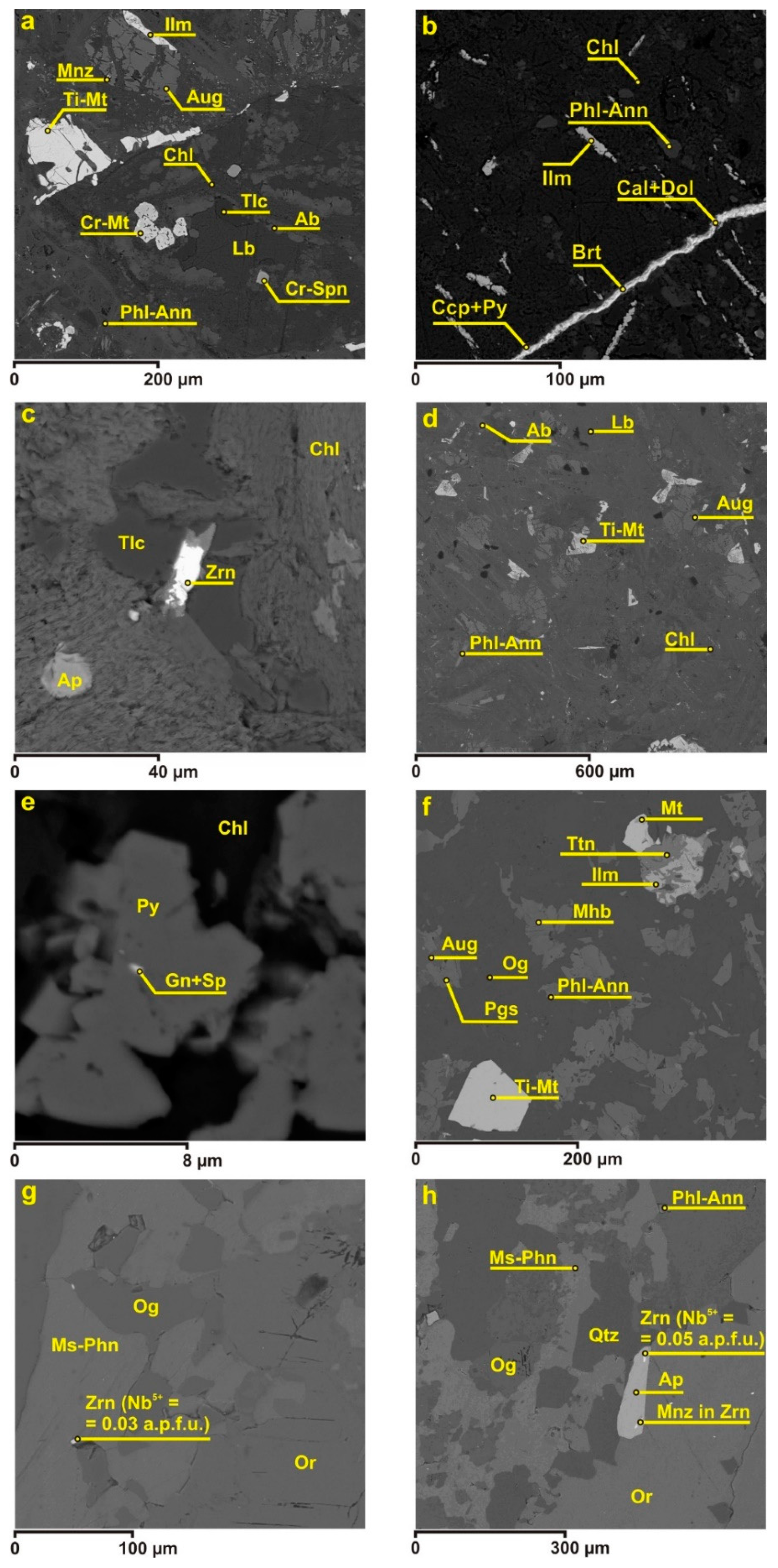
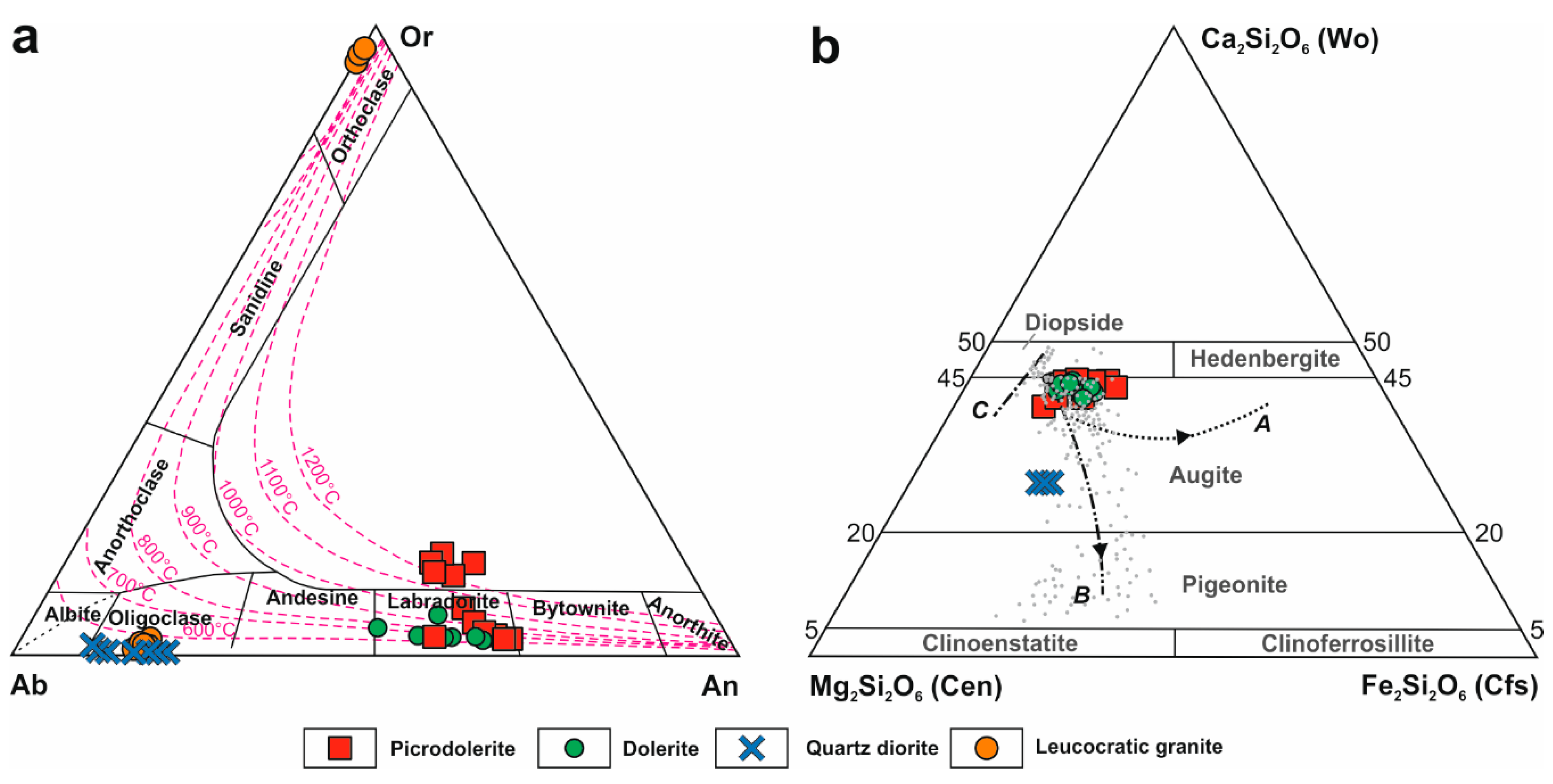
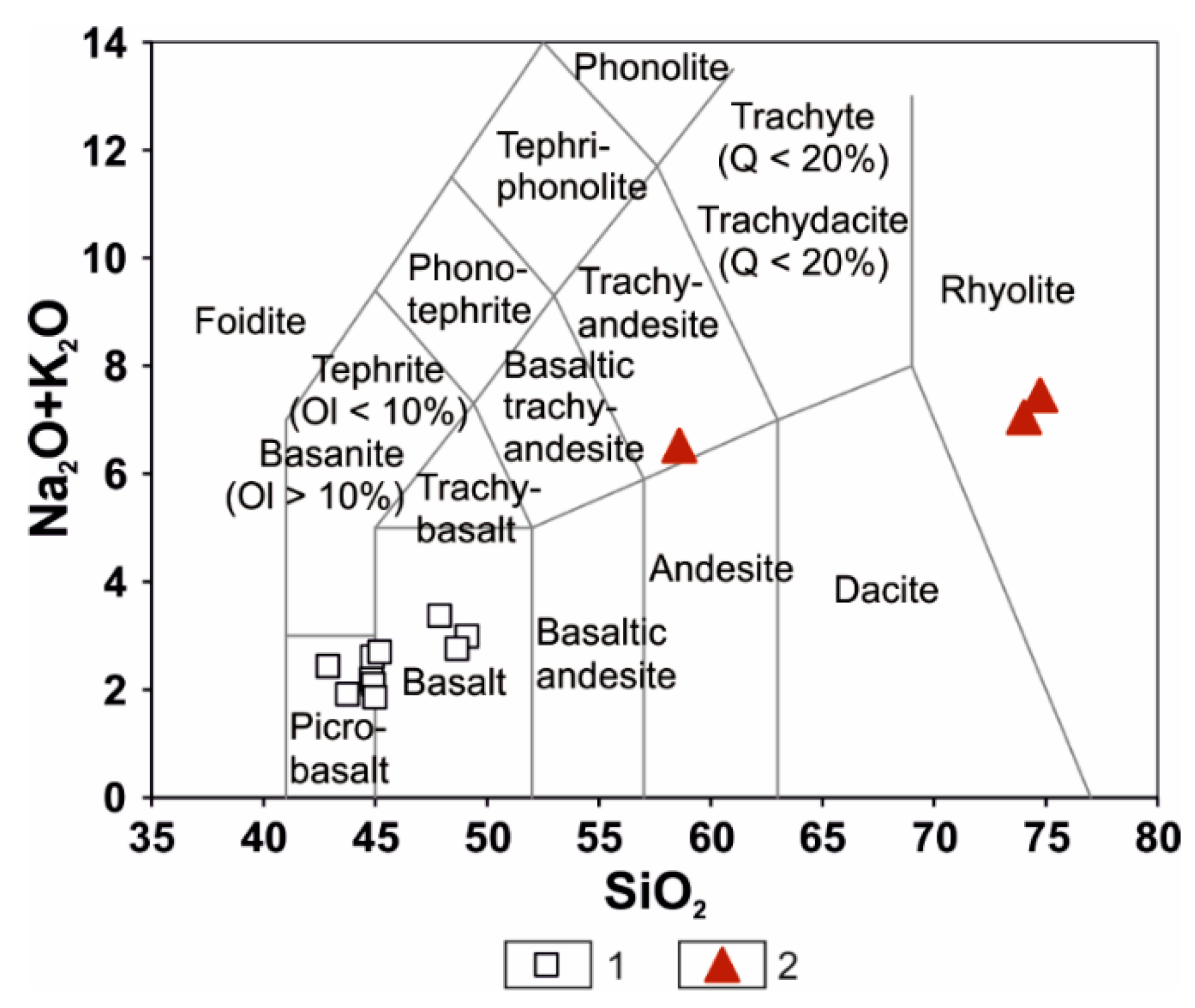
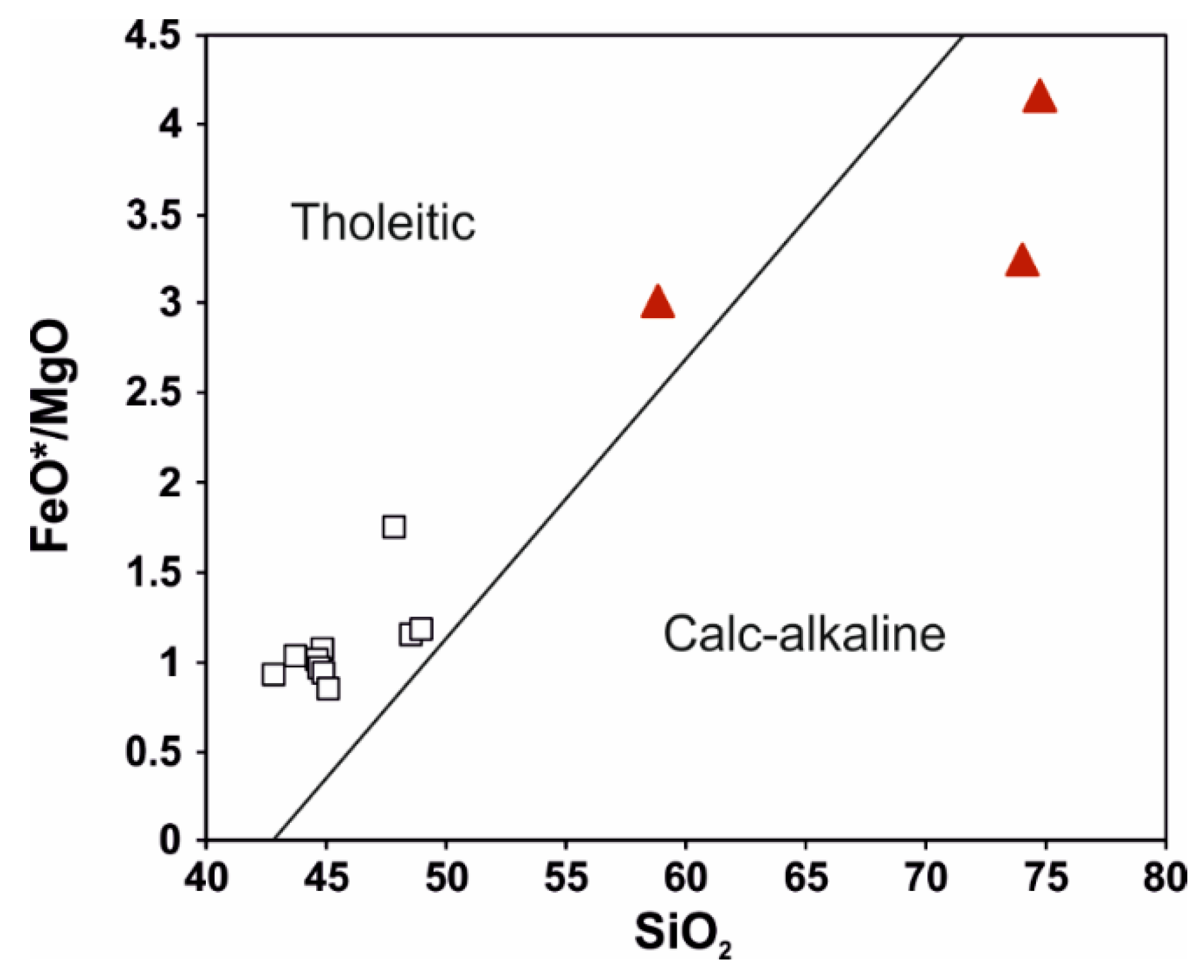
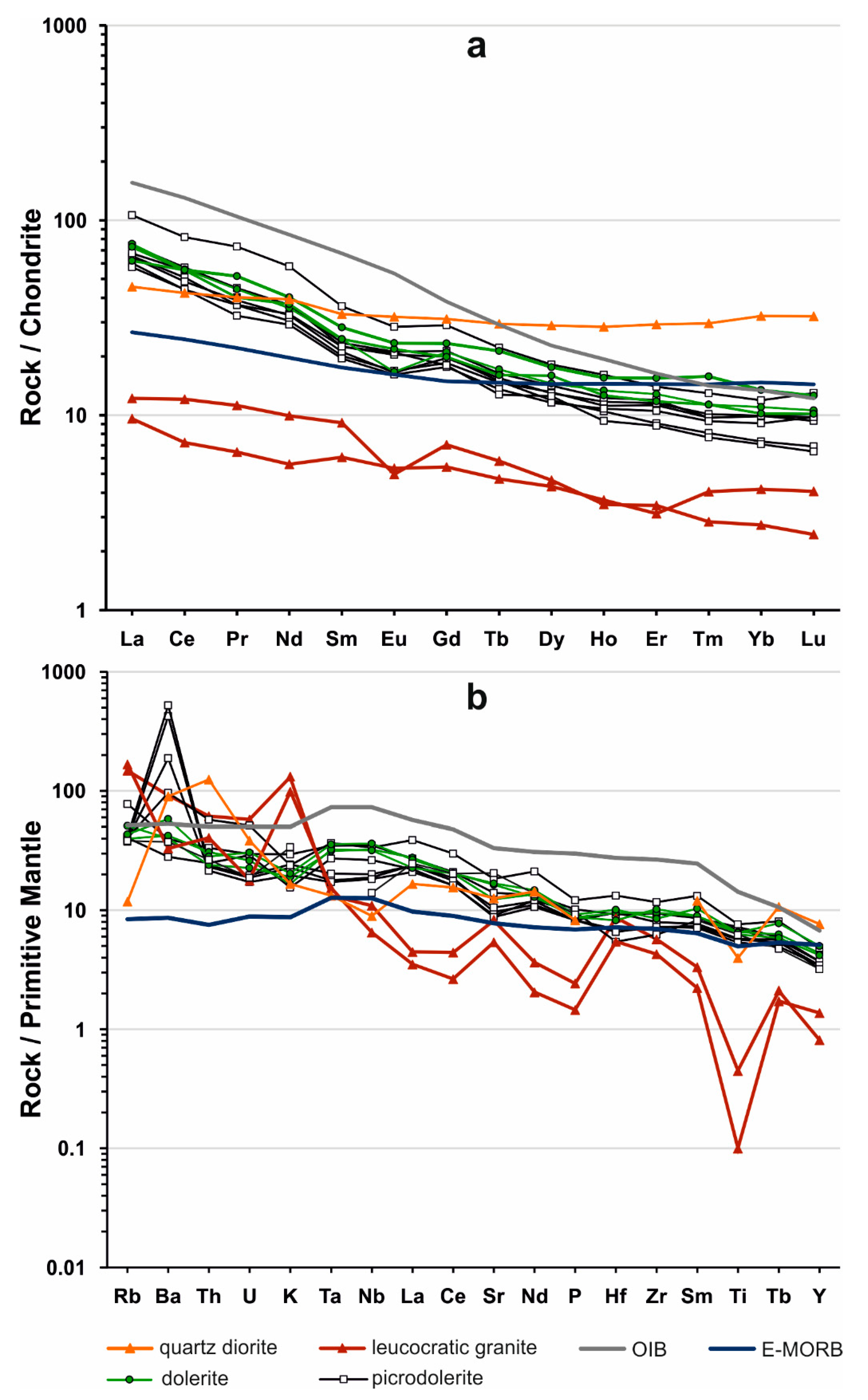
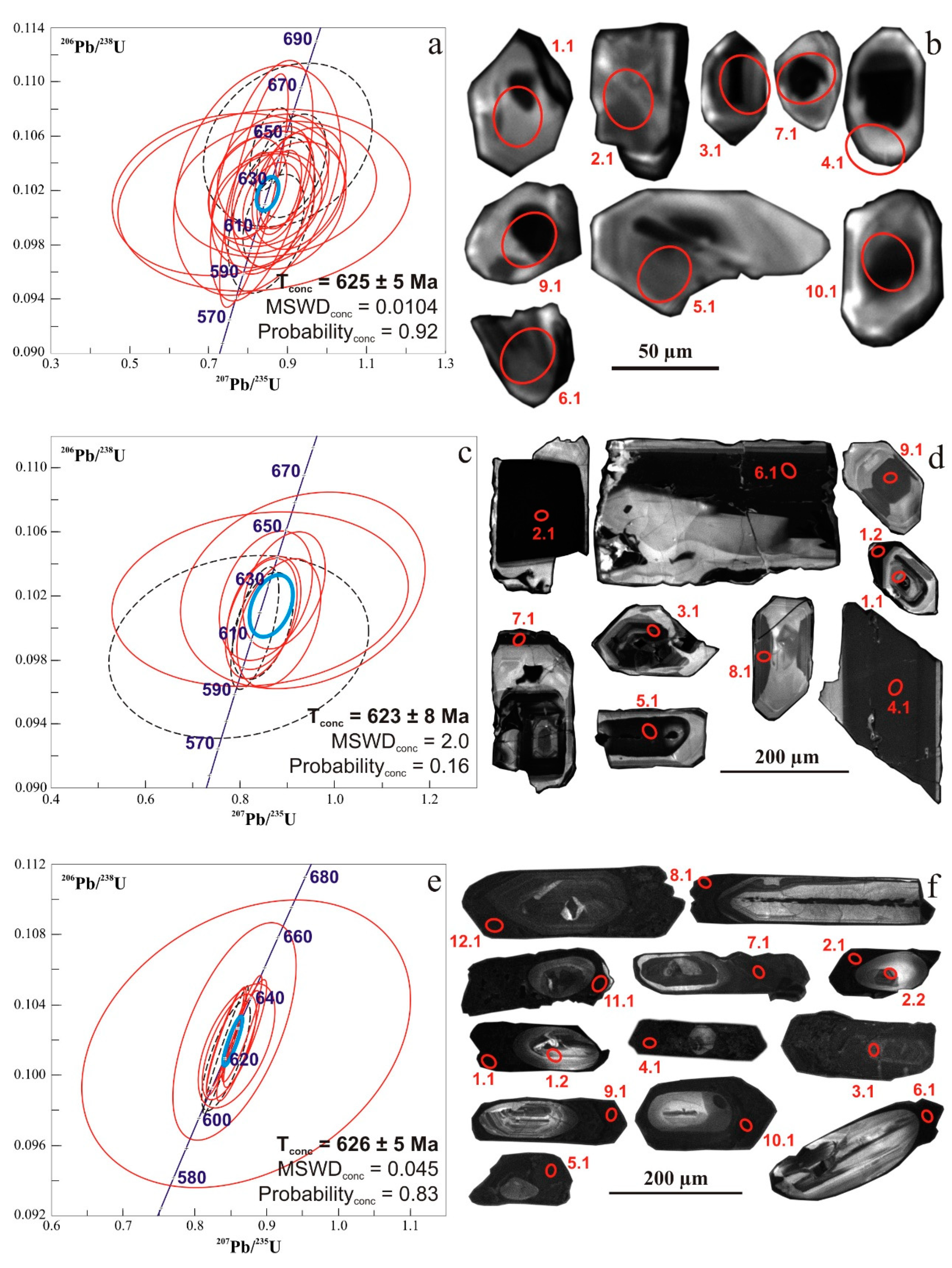
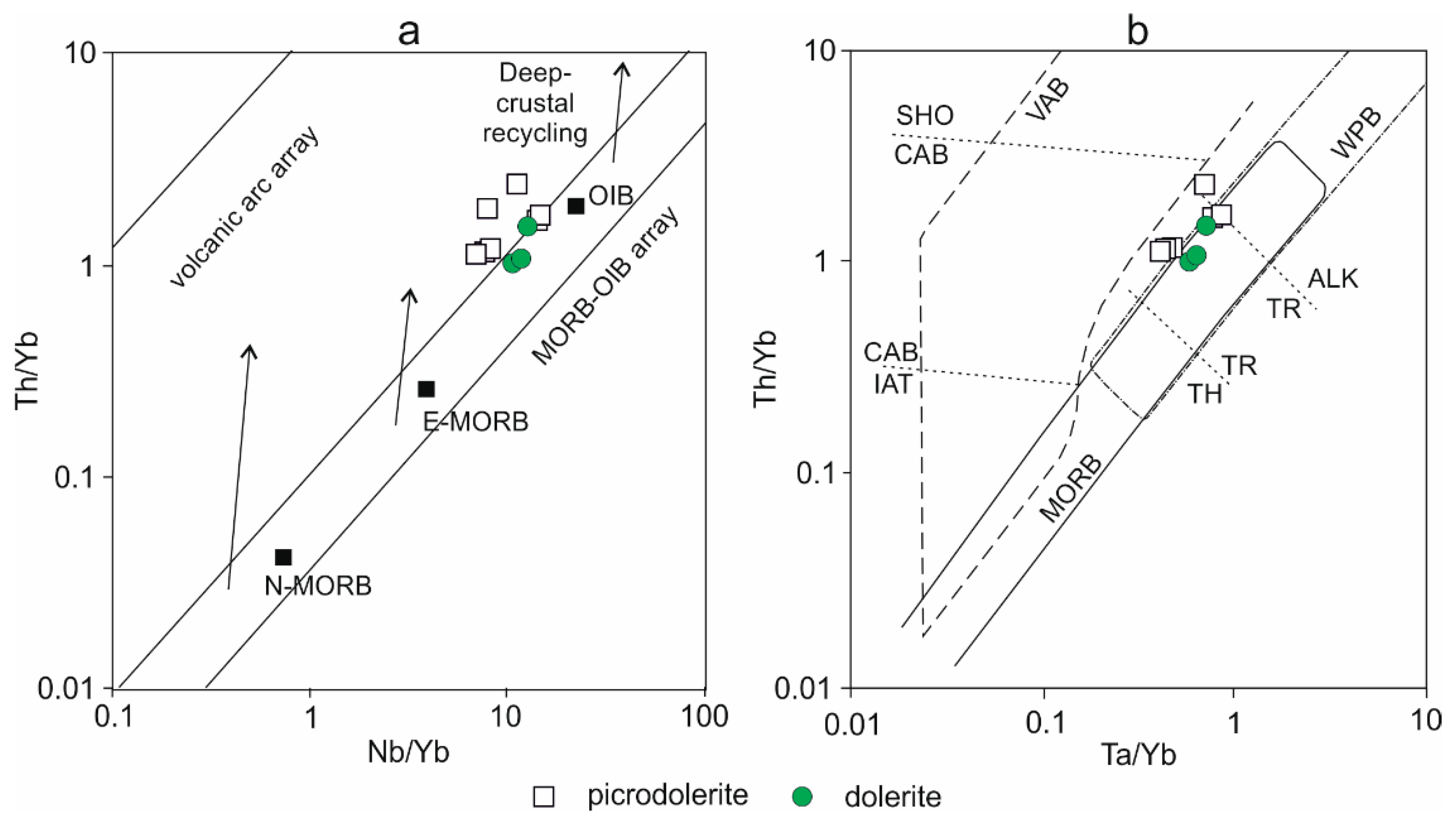
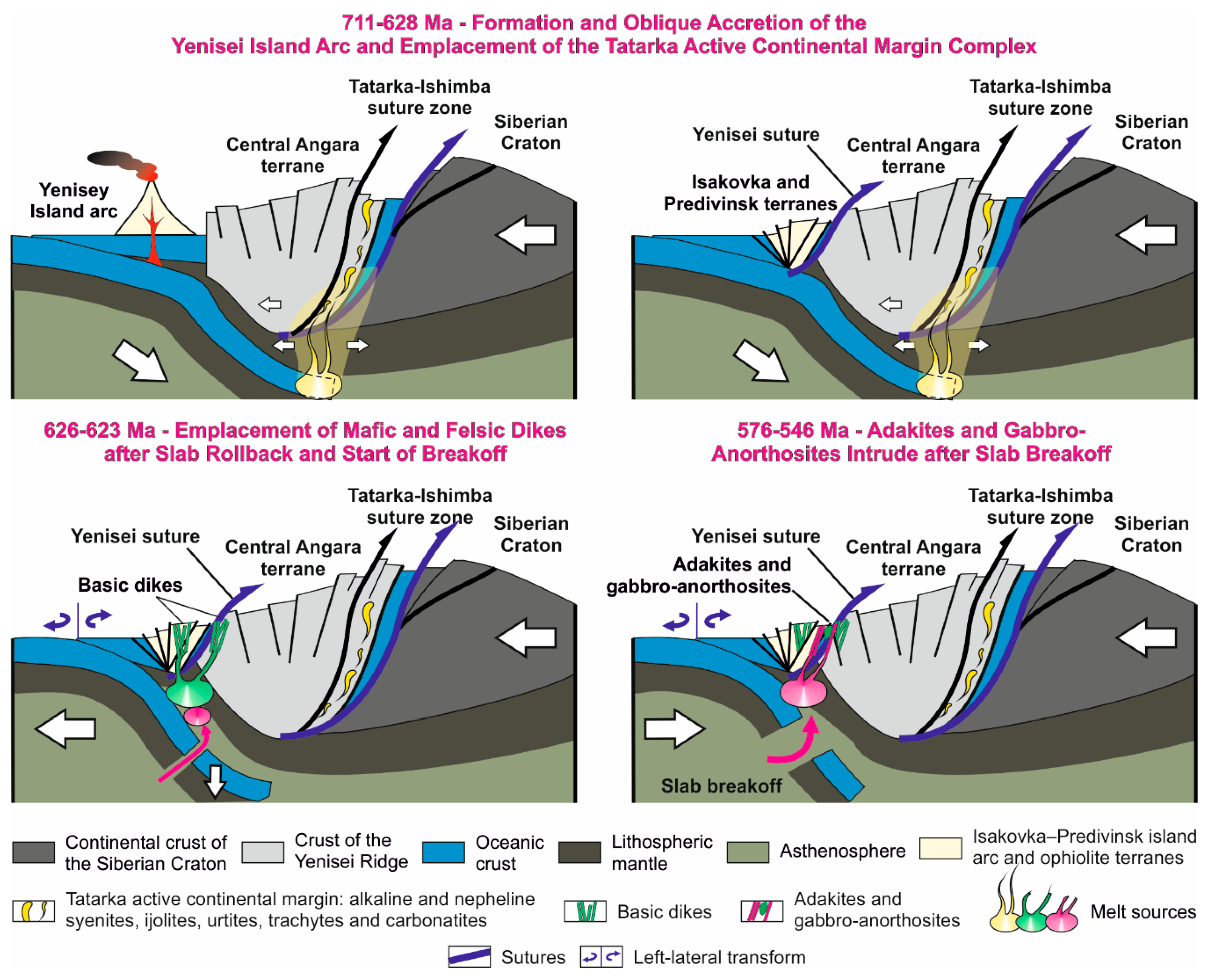
| Analyt. spot No. | Content, ppm | Isotope Ratios | Age, Ma | % D | |||||||||
|---|---|---|---|---|---|---|---|---|---|---|---|---|---|
| U | Th | 206Pb* | 232Th/238U | % 206Pbc | (1) 238U/206Pb* (±%) | (1) 207Pb*/206Pb* (±%) | (1) 207Pb*/235U (±%) | (1) 206Pb*/238U (±%) | Err. corr. | (1) 206Pb/238U (±%) | (1) 207Pb/206Pb (±%) | ||
| Sample YR16-4 (GPS coordinates: N 58°01’09.18”; E 93°12’17.46”) | |||||||||||||
| 12.1 | 150 | 159 | 12.8 | 1.10 | n.d. | 10.0 ± 1.4 | 0.0629 ± 3.4 | 0.87 ± 3.7 | 0.100 ± 1.4 | 0.4 | 613 ± 8 | 705 ± 72 | +14 |
| 16.1 | 32 | 26 | 2.72 | 0.85 | 0.00 | 10.0 ± 2.3 | 0.0622 ± 4.7 | 0.86 ± 5.2 | 0.100 ± 2.3 | 0.4 | 615 ± 14 | 682 ± 99 | +10 |
| 23.1 | 83 | 58 | 7.19 | 0.72 | 0.56 | 9.9 ± 1.7 | 0.0604 ± 6.1 | 0.84 ± 6.3 | 0.101 ± 1.7 | 0.3 | 617 ± 10 | 619 ± 132 | +0 |
| 4.1 | 49 | 38 | 4.29 | 0.79 | 0.22 | 9.91 ± 1.9 | 0.065 ± 6.3 | 0.905 ± 6.5 | 0.1009 ± 1.9 | 0.285 | 620 ± 11 | 776 ± 130 | 25 |
| 17.1 | 125 | 117 | 10.9 | 0.97 | 1.29 | 9.9 ± 1.5 | 0.0608 ± 6.5 | 0.85 ± 6.7 | 0.101 ± 1.5 | 0.2 | 621 ± 9 | 633 ± 140 | +2 |
| 7.1 | 236 | 276 | 20.6 | 1.21 | 0.31 | 9.89 ± 1.2 | 0.0617 ± 3.3 | 0.86 ± 3.5 | 0.1011 ± 1.2 | 0.336 | 621 ± 7.1 | 663 ± 72 | 7 |
| 5.1 | 33 | 24 | 2.91 | 0.75 | 2.13 | 9.86 ± 2.7 | 0.06 ± 18 | 0.84 ± 18 | 0.1013 ± 2.7 | 0.146 | 622 ± 16 | 608 ± 390 | −2 |
| 6.1 | 53 | 32 | 4.68 | 0.63 | 0.40 | 9.87 ± 2.2 | 0.0611 ± 5 | 0.854 ± 5.4 | 0.1013 ± 2.2 | 0.404 | 622 ± 13 | 644 ± 110 | 3 |
| 25.1 | 194 | 248 | 16.9 | 1.32 | 0.12 | 9.8 ± 1.3 | 0.0582 ± 2.5 | 0.81 ± 2.8 | 0.102 ± 1.3 | 0.5 | 624 ± 8 | 536 ± 55 | −17 |
| 1.1 | 31 | 25 | 2.77 | 0.83 | 1.47 | 9.82 ± 2.4 | 0.0537 ± 16 | 0.75 ± 16 | 0.1017 ± 2.4 | 0.149 | 624 ± 14 | 359 ± 360 | −43 |
| 18.1 | 260 | 320 | 22.7 | 1.27 | 0.18 | 9.8 ± 1.2 | 0.0626 ± 2.3 | 0.88 ± 2.6 | 0.102 ± 1.2 | 0.5 | 625 ± 7 | 694 ± 50 | +10 |
| 11.1 | 147 | 150 | 12.9 | 1.05 | n.d. | 9.8 ± 3.4 | 0.0579 ± 2.7 | 0.81 ± 4.3 | 0.102 ± 3.4 | 0.8 | 626 ± 21 | 526 ± 58 | −20 |
| 2.1 | 52 | 39 | 4.67 | 0.78 | 1.50 | 9.78 ± 2 | 0.0617 ± 12 | 0.87 ± 12 | 0.1021 ± 2 | 0.164 | 627 ± 12 | 664 ± 260 | 6 |
| 10.1 | 80 | 65 | 7.07 | 0.83 | 0.36 | 9.79 ± 1.7 | 0.0604 ± 7.1 | 0.851 ± 7.3 | 0.1021 ± 1.7 | 0.232 | 627 ± 10 | 618 ± 150 | −1 |
| 13.1 | 67 | 50 | 5.89 | 0.77 | 0.31 | 9.8 ± 1.8 | 0.0660 ± 4.9 | 0.93 ± 5.2 | 0.102 ± 1.8 | 0.3 | 627 ± 11 | 805 ± 103 | +23 |
| 24.1 | 135 | 135 | 11.8 | 1.03 | 0.40 | 9.8 ± 1.5 | 0.0567 ± 4.8 | 0.80 ± 5.0 | 0.102 ± 1.5 | 0.3 | 627 ± 9 | 482 ± 106 | −32 |
| 3.1 | 111 | 75 | 9.75 | 0.70 | n.d. | 9.74 ± 1.4 | 0.0631 ± 2.7 | 0.893 ± 3 | 0.1027 ± 1.4 | 0.472 | 630 ± 8.6 | 711 ± 57 | 13 |
| 22.1 | 101 | 56 | 8.9 | 0.58 | 0.43 | 9.7 ± 3.5 | 0.0589 ± 5.3 | 0.83 ± 6.3 | 0.103 ± 3.5 | 0.6 | 630 ± 21 | 564 ± 115 | −12 |
| 14.1 | 76 | 52 | 6.72 | 0.70 | 1.49 | 9.7 ± 3.4 | 0.0580 ± 9.9 | 0.82 ± 10.5 | 0.103 ± 3.4 | 0.3 | 630 ± 20 | 531 ± 218 | −20 |
| 20.1 | 85 | 78 | 7.59 | 0.94 | n.d. | 9.7 ± 1.7 | 0.0606 ± 6.5 | 0.86 ± 6.7 | 0.103 ± 1.7 | 0.2 | 634 ± 10 | 626 ± 140 | −1 |
| 9.1 | 130 | 131 | 11.7 | 1.04 | 0.37 | 9.63 ± 1.5 | 0.0635 ± 3.7 | 0.909 ± 4 | 0.1038 ± 1.5 | 0.373 | 637 ± 9 | 726 ± 79 | 14 |
| 19.1 | 307 | 387 | 27.7 | 1.30 | n.d. | 9.5 ± 1.2 | 0.0592 ± 2.2 | 0.86 ± 2.5 | 0.105 ± 1.2 | 0.5 | 644 ± 7 | 575 ± 49 | −13 |
| 15.1 | 35 | 36 | 3.17 | 1.07 | 0.64 | 9.5 ± 2.3 | 0.0620 ± 9.4 | 0.90 ± 9.7 | 0.105 ± 2.3 | 0.2 | 646 ± 14 | 675 ± 202 | +5 |
| Sample A09-11 (GPS coordinates N 57°04’36.90”; E 93°26’9.80”) | |||||||||||||
| 8.1 | 18 | 16 | 1.5 | 0.96 | n.d. | 10.12 ± 2.4 | 0.0585 ± 13.9 | 0.797 ± 14.1 | 0.0988 ± 2.4 | 0.2 | 608 ± 14 | 549 ± 303 | −11 |
| 1.2 | 183 | 267 | 15.8 | 1.51 | n.d. | 10.00 ± 1.6 | 0.0603 ± 2.0 | 0.831 ± 2.5 | 0.1000 ± 1.6 | 0.6 | 614 ± 9 | 614 ± 43 | -0 |
| 5.1 | 174 | 228 | 15 | 1.35 | 0.36 | 9.99 ± 1.4 | 0.0614 ± 2.8 | 0.848 ± 3.1 | 0.1001 ± 1.4 | 0.4 | 615 ± 8 | 654 ± 59 | +6 |
| 4.1 | 55 | 50 | 4.73 | 0.94 | 0.20 | 9.97 ± 1.6 | 0.0637 ± 3.7 | 0.882 ± 4.1 | 0.1003 ± 1.6 | 0.4 | 616 ± 10 | 733 ± 79 | +17 |
| 7.1 | 83 | 131 | 7.19 | 1.62 | 0.16 | 9.94 ± 1.5 | 0.0609 ± 3.3 | 0.845 ± 3.7 | 0.1006 ± 1.5 | 0.4 | 618 ± 9 | 637±72 | +3 |
| 2.1 | 122 | 117 | 10.5 | 0.99 | 0.35 | 9.91 ± 1.4 | 0.0611 ± 3.5 | 0.851 ± 3.8 | 0.1010 ± 1.4 | 0.4 | 620 ± 8 | 643 ± 75 | +4 |
| 1.1 | 29 | 17 | 2.54 | 0.62 | n.d. | 9.82±2.2 | 0.0600 ± 15.1 | 0.842 ± 15.2 | 0.1018 ± 2.2 | 0.1 | 625 ± 13 | 602 ± 326 | -4 |
| 6.1 | 74 | 80 | 6.48 | 1.12 | n.d. | 9.80 ± 1.6 | 0.0607 ± 4.4 | 0.854 ± 4.7 | 0.1020 ± 1.6 | 0.3 | 626 ± 10 | 630 ± 95 | +1 |
| 9.1 | 17 | 17 | 1.48 | 1.05 | 0.77 | 9.77 ± 2.5 | 0.0661 ± 11.0 | 0.933 ± 11.3 | 0.1024 ± 2.5 | 0.2 | 628 ± 15 | 810 ± 231 | +24 |
| 3.1 | 95 | 84 | 8.37 | 0.91 | n.d. | 9.77 ± 1.5 | 0.0632 ± 3.7 | 0.893 ± 4.0 | 0.1024 ± 1.5 | 0.4 | 628 ± 9 | 716 ± 79 | +13 |
| Sample M08-3 (GPS coordinates: N 57°01’13.70”; E 93°22’12.30”) | |||||||||||||
| 6.1 | 6750 | 730 | 586 | 0.11 | 0.01 | 9.89 ± 1.3 | 0.0605 ± 1.1 | 0.843 ± 1.6 | 0.1011 ± 1.3 | 0.8 | 621 ± 7 | 622 ± 23 | +0 |
| 10.1 | 7610 | 590 | 663 | 0.08 | n.d. | 9.86 ± 1.5 | 0.0603 ± 0.3 | 0.843 ± 1.5 | 0.1014 ± 1.5 | 1.0 | 623 ± 9 | 613 ± 8 | −2 |
| 8.1 | 2210 | 44 | 193 | 0.02 | 0.01 | 9.84±1.2 | 0.0605 ± 1.3 | 0.848 ± 1.8 | 0.1016 ± 1.2 | 0.7 | 624 ± 7 | 622 ± 29 | −0 |
| 11.1 | 3207 | 64 | 280 | 0.02 | 0.04 | 9.84 ± 1.3 | 0.0614 ± 0.7 | 0.860 ± 1.4 | 0.1017 ± 1.3 | 0.9 | 624 ± 8 | 653 ± 15 | +5 |
| 7.1 | 956 | 24 | 83.5 | 0.03 | 0.40 | 9.84 ± 1.4 | 0.0612 ± 2.1 | 0.858 ± 2.5 | 0.1017 ± 1.4 | 0.6 | 624 ± 8 | 646 ± 45 | +4 |
| 1.1 | 3156 | 169 | 276 | 0.06 | 17.38 | 9.82 ± 3.3 | 0.0621 ± 10.2 | 0.871 ± 10.7 | 0.1018 ± 3.3 | 0.3 | 625 ± 20 | 677 ± 218 | +8 |
| 4.1 | 2306 | 56 | 202 | 0.02 | 0.01 | 9.81 ± 1.2 | 0.0600 ± 0.5 | 0.844 ± 1.3 | 0.1019 ± 1.2 | 0.9 | 626 ± 7 | 605 ± 12 | −4 |
| 2.1 | 2715 | 42 | 238 | 0.02 | 0.08 | 9.81 ± 1.2 | 0.0599 ± 0.5 | 0.842 ± 1.3 | 0.1020 ± 1.2 | 0.9 | 626 ± 7 | 600 ± 11 | −5 |
| 9.1 | 1400 | 17 | 123 | 0.01 | 0.08 | 9.77 ± 1.2 | 0.0617 ± 0.7 | 0.870 ± 1.4 | 0.1024 ± 1.2 | 0.9 | 628 ± 7 | 662 ± 15 | +5 |
| 12.1 | 630 | 6 | 55.5 | 0.01 | 0.06 | 9.76 ± 2.5 | 0.0605 ± 3.3 | 0.855 ± 4.1 | 0.1025± 2.5 | 0.6 | 629 ± 15 | 623 ± 71 | −1 |
| 5.1 | 2676 | 40 | 236 | 0.02 | n.d. | 9.74 ± 1.2 | 0.0612 ± 0.5 | 0.866 ± 1.3 | 0.1026 ± 1.2 | 0.9 | 630 ± 7 | 645 ± 11 | +3 |
| 2.2 | 74 | 48 | 7.74 | 0.67 | 0.36 | 8.24 ± 1.7 | 0.0650 ± 3.4 | 1.088 ± 3.8 | 0.1213 ± 1.7 | 0.4 | 738 ± 12 | 775 ± 71 | +5 |
| 3.1 | 319 | 127 | 34 | 0.41 | 1.53 | 8.08 ± 1.3 | 0.0659 ± 3.3 | 1.125 ± 3.5 | 0.1238 ± 1.3 | 0.4 | 752 ±9 | 805 ± 69 | +7 |
| 1.2 | 81 | 69 | 9.5 | 0.88 | n.d. | 7.32 ± 1.6 | 0.0663 ± 4.0 | 1.249 ± 4.3 | 0.1366 ± 1.6 | 0.4 | 825 ± 12 | 817 ± 84 | −1 |
© 2020 by the authors. Licensee MDPI, Basel, Switzerland. This article is an open access article distributed under the terms and conditions of the Creative Commons Attribution (CC BY) license (http://creativecommons.org/licenses/by/4.0/).
Share and Cite
Vernikovskaya, A.; Vernikovsky, V.A.; Matushkin, N.; Kadilnikov, P.; Metelkin, D.V.; Romanova, I.; Li, Z.-X.; Bogdanov, E. Early Ediacaran Magmatism in the Yenisei Ridge and Evolution of the Southwestern Margin of the Siberian Craton. Minerals 2020, 10, 565. https://doi.org/10.3390/min10060565
Vernikovskaya A, Vernikovsky VA, Matushkin N, Kadilnikov P, Metelkin DV, Romanova I, Li Z-X, Bogdanov E. Early Ediacaran Magmatism in the Yenisei Ridge and Evolution of the Southwestern Margin of the Siberian Craton. Minerals. 2020; 10(6):565. https://doi.org/10.3390/min10060565
Chicago/Turabian StyleVernikovskaya, Antonina, Valery A. Vernikovsky, Nikolay Matushkin, Pavel Kadilnikov, Dmitry V. Metelkin, Irina Romanova, Zheng-Xiang Li, and Egor Bogdanov. 2020. "Early Ediacaran Magmatism in the Yenisei Ridge and Evolution of the Southwestern Margin of the Siberian Craton" Minerals 10, no. 6: 565. https://doi.org/10.3390/min10060565
APA StyleVernikovskaya, A., Vernikovsky, V. A., Matushkin, N., Kadilnikov, P., Metelkin, D. V., Romanova, I., Li, Z.-X., & Bogdanov, E. (2020). Early Ediacaran Magmatism in the Yenisei Ridge and Evolution of the Southwestern Margin of the Siberian Craton. Minerals, 10(6), 565. https://doi.org/10.3390/min10060565







